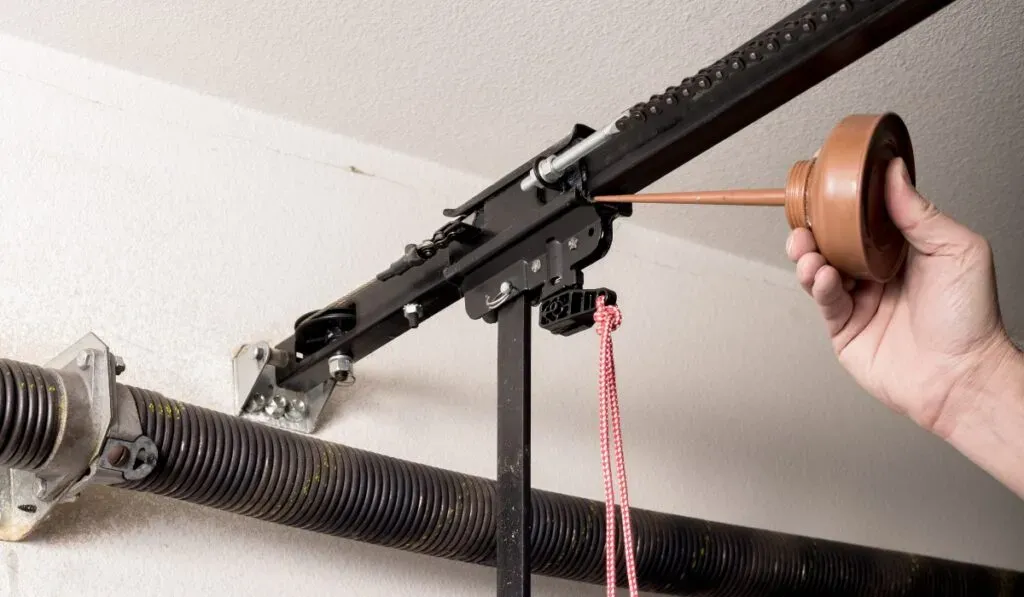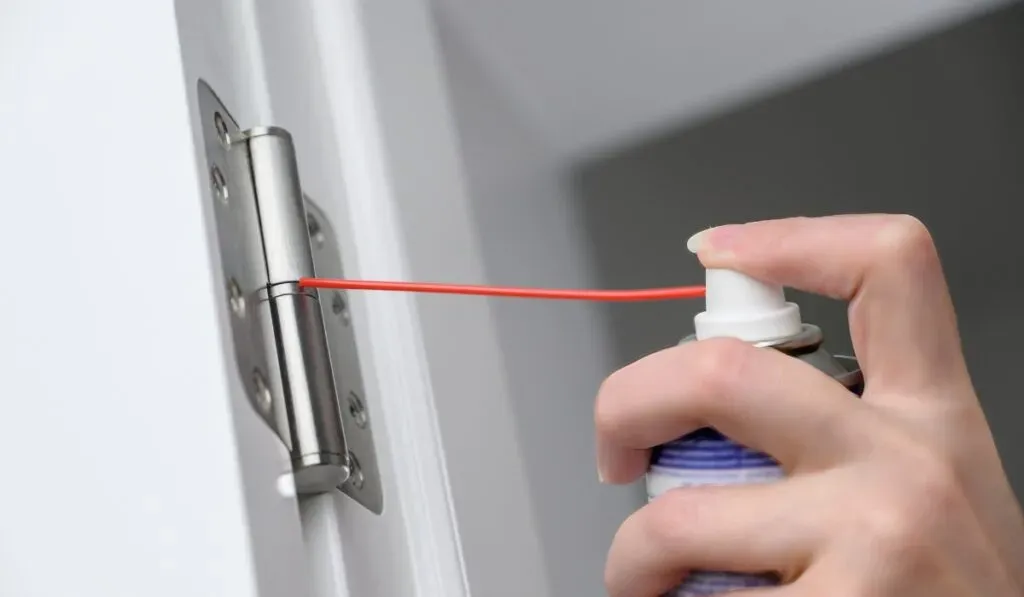
The best lubricant for garage doors is essential to keep all garage door components working smoothly and prevent wear over time. Learning how to properly lubricate your garage door with high-quality garage door lubricant helps reduce noise and extend the lifespan of springs, rollers, and hinges.
Introduction to Garage Door Lubrication
Lubricating your garage door is a simple way to keep it running smooth. Picking the best lubricant for garage door parts can cut down friction. That helps prevent breakdowns and keeps everything moving well. Regular garage door lubrication fits right into garage door maintenance. It’s a kind of proactive maintenance that saves you time and money later.
Importance of Using the Right Lubricant for Garage Door Components
Not every part needs the same type of lubricant. Here’s a quick look:
- Lubricant for garage door rollers helps them roll along the tracks without sticking.
- Lubricant for garage door hinges stops squeaks and makes opening easier.
- Lubricant for garage door springs keeps them from rusting and losing tension.
If you put the right stuff on these parts, you get long-lasting lubrication that keeps the door quiet and working right.
Quick Overview: Recommended Lubricants and What to Avoid
Here’s what works best:
- Silicone-based lubricants shine for water resistance.
- Lithium grease sticks around longer on metal parts.
Watch out: WD-40 is not really a lubricant. It cleans but doesn’t protect your parts well. So skip WD-40 when doing garage door maintenance.
Silicone vs. Lithium vs. PTFE Lubricants: Where to Apply Each
Picking the best lubricant for garage door care depends on the type and where you use it. Silicone, lithium, and PTFE all work well but in different spots.
- Silicone Lubricant for Garage Door:- Silicone lubricants stick well to plastic, rubber, and metal. They keep moisture out and stop rust. Plus, they don’t grab dirt or grime. Use silicone on nylon rollers, weather seals, and cleaned tracks. It works great as a dry lubricant that won’t gum up parts.
- Lithium Grease for Garage Door:- White lithium grease is thicker. It lasts longer under tough use. This stuff works best on metal parts like hinges, springs, bearing plates, and steel rollers. It resists water and stops rust while cutting friction on parts that get heavy use.
- PTFE Lubricant Garage Door Applications:- PTFE sprays create a slick surface with very low friction—kind of like Teflon. Use them on metal parts such as springs and rollers, plus plastic parts too. They don’t pull in dust or dirt easily.
Identifying Garage Door Parts That Require Lubrication
Knowing what garage door parts need lube helps keep things smooth without wasting it or causing damage by putting it where you shouldn’t.
Key Parts to Lubricate
- Garage Door Rollers: Use silicone spray for nylon rollers so plastic doesn’t get ruined.
- Hinges: White lithium grease stops squeaks at pivot points.
- Springs: Lightly put lithium grease or PTFE spray on garage door springs to stop rust but don’t add too much.
- Bearing Plates: These help springs move smoothly; put thin layers of lithium grease here.
Parts to Avoid Lubricating
- Tracks: Don’t lube tracks directly. Clean them well first. You can spray silicone lightly near edges but not inside track channels to avoid dirt build-up.
- Nylon Rollers’ Bearings Only: Roller wheels like silicone sprays since they are plastic. The bearings inside might need little grease based on your door’s instructions—check the manual.
If you live near the ocean, salt air can speed up rusting—choose marine-grade lubes that handle saltwater when you can find them.
Focusing lube only where needed helps your garage door last longer without sticky gunk that causes problems later. Using silicone lubricant for soft parts and white lithium grease on metals keeps things running smooth.
How to Properly Lubricate Your Garage Door Components
Lubricating your garage door keeps it running smooth and quiet. Focus on parts that move a lot, like hinges, rollers, and springs. Don’t put lubricant on the tracks. Instead, clean them to stop dirt from building up.
Pre-Lubrication Maintenance Checklist
Before you start lubing:
- Clean the Tracks: Wipe dirt and dust off with a damp cloth or mild cleaner. Never add lubricant here.
- Inspect Components: Look for wear or damage on hinges, rollers, springs, and bearing plates.
- Tighten Hardware: Make sure bolts and screws are snug.
- Safety Precautions: Wear gloves and eye protection. Work in a space with fresh air. Keep away from open flames.
Step-by-Step Lubrication Process
- Gather Supplies: Get a silicone- or lithium-based aerosol lubricant made for garage doors. Use a grease gun for tricky spots.
- Lubricate Hinges: Put lubricant on each hinge pivot point to stop squeaks.
- Lubricate Rollers: Spray or apply lubricant around the roller bearings only, and consider professional garage door roller replacement if rollers show signs of wear. Avoid the wheel surfaces.
- Lubricate Springs: Cover torsion and extension springs evenly so they stay flexible.
- Avoid Tracks Lubrication: Just clean tracks; no lubricant there to prevent dirt jams.
- Wipe Excess Lubricant: Use a clean rag to remove extra oil that might drip or attract dust.
Use small amounts when applying lube to spread it evenly without overdoing it. Over-lubricating causes buildup or slipping problems.
Tips for Correct Lubricant Application
- Put little drops at each point instead of soaking parts.
- Open and close the door a few times to spread the lube evenly.
- Always wipe off any leftover lubricant right after applying to avoid mess and dirt sticking.
Recommended Frequency for Garage Door Lubrication
How often you lubricate your garage door depends on how much you use it, weather, and age of parts.
- Most homes should lube every 3–6 months for smooth action.
- If you live near the coast, do it more often—every 2–3 months works better because salt air can cause rust.
- After heavy use times (like winter snow removal), check if it needs lube sooner.
Doing seasonal maintenance helps parts last longer and keeps noises away from dry spots.
Signs It’s Time To Re-Lubricate Your Garage Door
- Squeaking sounds when opening or closing
- Jerky or stiff door movement
- Dry-looking hinges, rollers, or springs
- Hard time lifting the door by hand
Try opening the door fully then close it slow. Smooth motion means good lubrication; if you feel resistance, it’s time to lube again.
Follow these steps to keep your garage door quiet and lasting longer all year round by lubing right and knowing when to do it, or consider professional garage door maintenance for comprehensive care.
Environmental Impact of Different Garage Door Lubricants

Picking the right lubricant for your garage door means thinking about how it affects the environment. Petroleum-based lubricants have chemicals that can harm soil and water if spilled or thrown away wrong. They also give off volatile organic compounds (VOCs) that pollute the air.
Silicone-based lubricants are usually better for the environment. They don’t break down as fast but are less toxic and release fewer VOCs. Biodegradable lubricants are even greener because they break down naturally without leaving bad stuff behind.
If you want an eco-friendly garage door lubricant, look for ones called biodegradable or made from plants. These choices cause less harm but still keep your door running smooth.
Here’s a quick look:
- Petroleum-based: harmful chemicals, pollutes soil and water, high VOCs
- Silicone-based: lower toxicity, fewer VOCs, slow breakdown
- Biodegradable: breaks down naturally, low environmental damage
Proper Disposal and Packaging Considerations
Getting rid of old garage door lubricant the right way helps protect nature and follows the rules. Don’t dump leftover lubricant down drains, on soil, or in storm drains. This pollutes water sources.
Try these disposal steps instead:
- Take used lubricant to hazardous waste centers
- Check local recycling programs for chemical products
- Use all the product before tossing containers
Also, think about packaging when buying lubricants. Look for recyclable containers like metal cans or plastic bottles with recycling marks. Aerosol cans need special care since they’re pressurized. Empty them fully and follow local rules before recycling.
Remember:
- Don’t pour lubricant into drains or soil
- Use hazardous waste centers when possible
- Pick recyclable packaging when you can
- Handle aerosol cans carefully
Lubricant Safety Tips for DIY Maintenance
When you work on your garage door yourself, safety matters a lot. Keep these tips in mind:
- Use lubricants in a well-ventilated area to avoid breathing fumes
- Read all labels before starting
- Wear gloves to keep skin safe from irritation
- Keep away from open flames because many lubricants catch fire easily
- Clean up spills right away to stop slipping accidents
By following these safety tips, you protect yourself and help your garage door run smoothly without trouble.
Quick safety checklist:
- Work where air flows freely
- Follow product instructions
- Wear protective gloves
- Avoid flames near lubricants
- Clean spills fast to prevent slips
Extending the Life of Your Garage Door Through Proper Lubrication
The best lubricant for garage door care keeps parts moving smoothly and cuts down on friction. Regular garage door lubrication gives long-lasting protection and helps stop wear and tear. This simple step prevents premature breakdowns and makes your door last longer.
When metal parts rub together, they can get damaged. Using the right lubricant creates a layer that stops grinding and sticking. This keeps your door working well and saves you money on fixes later.
How Regular Lubrication Reduces Noise and Wear on Components
A noisy garage door usually means some parts are dry or worn out. Garage door noise reduction starts with lubing hinges, rollers, and springs to quiet them down. Without lubrication, metal parts rub hard and make squeaks or rattles.
Applying lubricant regularly helps parts move smoothly with less friction. That cuts annoying sounds and stops early wear. For noisy garage door solutions, keep up with lubing using products made for metal exposed to weather.
Preventing Costly Repairs by Maintaining Smooth Operation of Springs, Rollers, and Hinges
Springs handle heavy loads every time the door opens. Rollers guide the door along tracks. Hinges hold panels together tight. All these need proper lubrication to avoid strain or breaking.
Use a special lubricant for garage door springs that keeps tension without grabbing dirt. Also, apply lubricant for garage door rollers and hinges often to cut down friction where metal touches metal.
Keeping these parts smooth stops extra stress. It lowers the chance of sudden breaks that lead to costly repairs or unsafe doors.
Troubleshooting Common Issues Related to Garage Door Lubrication
Garage door lubrication helps cut down friction and keeps things running smooth. If your door squeaks, sticks, or jerks, lubrication might be the problem. Don’t use WD-40 on garage doors. It can remove grease but leaves slippery spots that cause hazards. First, clean off any stubborn grime before adding the best lubricant for garage door parts.
Look out for these signs:
- Squeaky or grinding sounds when opening or closing
- Hinges and rollers that feel stiff or stuck
- Dirt and old grease building up visibly
Fixing these early stops extra wear and helps your door work quietly again.
Diagnosing Noisy or Sticking Garage Doors Caused by Lubrication Problems
Noisy doors often mean parts are dry or have the wrong lubricant. Greasy stuff like heavy grease can catch dust and grime, making things worse over time. Spray lubricants made for garage doors spread better and don’t leave sticky messes.
To check what’s wrong:
- Look at hinges, rollers, springs, and bearing plates for dryness or gunk.
- Clean each part well before putting on new lubricant.
- Wipe off any extra lubricant to keep dirt away.
Grease vs spray lubricant? Sprays suit moving metal parts better because they don’t get sticky like thick grease does.
Steps to Resolve Common Lubrication-Related Issues Safely
Try these steps for safe and proper lubrication:
- Clean moving parts with a dry cloth to get rid of dust and old grease.
- Apply silicone or lithium-based lubricant evenly — just enough.
- Don’t over-lubricate; too much drips and creates slippery spots.
- Wear gloves while applying to protect your skin.
- Make sure the area is well-ventilated if spraying indoors.
- Test the door several times to see if it moves smoothly and quietly.
These tips help you fix problems without making a mess or causing new ones.
